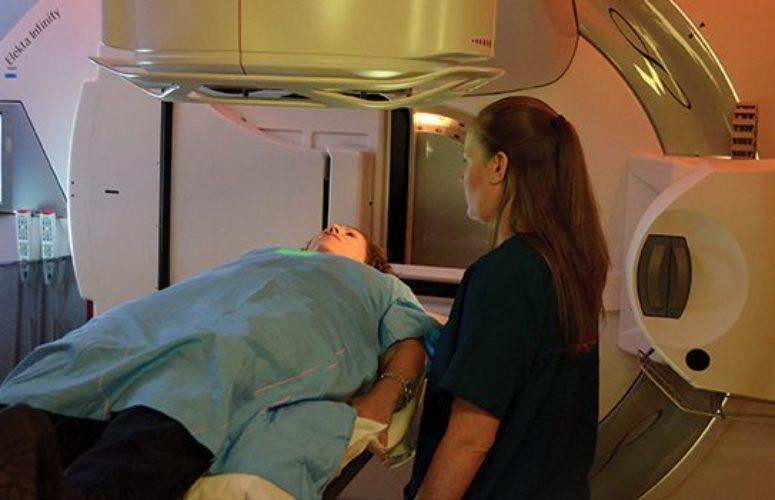
Tailored Care: The Future of Cancer Treatment
By Joao-Pierre Ruth, Contributing Writer On Nov 23, 2016At a time when incidents of cancer seem to be on the rise, some solace and hope can be found in the technology and treatment efforts available from New Jersey hospitals.
Institutions such as Cooper University Health Care, Hackensack Meridian Health, Englewood Hospital and Medical Center, RWJBarnabas Health, Virtua Health System, and CentraState Healthcare System have been adopting new methods to tackle this constantly-changing disease. With a focused approach, these hospital systems aim to deliver efficient care that may offer patients better outcomes and improved quality of life.
The cancer program at the MD Anderson Cancer Center at Cooper, which has offices across Central and Southern New Jersey, has dramatically changed in the past three years, says Dr. Generosa Grana, director of the center. “In 2013, we entered into a relationship with MD Anderson Cancer Center in Houston. That led to a renewed focus on cancer treatment,” she says. The 100,000-square-foot cancer center in Camden, across from the hospital, offers radiation oncology, surgical oncology, and medical oncology. The 75,000-square-foot facility in Voorhees offers similar services, and a smaller program operates in Willingboro.
MD Anderson Cancer Center at Cooper’s treatment services include Gamma Knife, Cyber Knife, and robotic surgery for less-invasive procedures with smaller incisions that allow patients to recovery more quickly. “You can often need less narcotics and transfusions, get discharged from the hospital sooner and have less pain,” Grana says. Cyber Knife, for example, is a newer technology that uses focused radiation to target difficult-to-reach lesions in lungs, the pancreas, and the prostate to avoid damaging healthy tissue.
The Gamma Knife is used in a comparable way to treat brain lesions. “We anticipate we will see about 3,000 new cancer patients in 2016,” Grana says. “That doesn’t include the large number of patients that are continuing on care through surgery, radiation, gynecological oncology, and medical oncology.”
Some of the larger programs at Cooper focus on primary and metastatic brain tumors. The cancer treatment efforts include actively working on clinical trials to bring newer agents and drugs into the clinic.
On the medical oncology side, newer drugs are available that work much more effectively and are less toxic in providing treatment – especially in treating forms of breast cancer.
There is a focus on personalized medicine, with the concept of targeting drugs to specific alterations that are occurring in cancers. “We are learning about the genetic changes cancers experience, but we’re lagging a little bit still in terms of finding drugs to target those,” she says.
Grana would like to see more attention paid to early detection, screening, newer screening modalities, contrast enhanced mammography, and newer MRI technology. “Personalized medicine is really personalized management of risk,” she says.
Her center also has a genetics program that explores hereditary cancer as well as other conditions. The program is extending testing to more patients and looking at genome profiling to help with management of a cancer. It is also bringing clinical trials from Houston to New Jersey.
Even with improvements in cancer outcomes, screening and early detection remain both challenging and crucial to overall care. “The earlier you find cancer, the less aggressive the treatment will be and the better your outcome will be,” she says.
Now there are guidelines for lung cancer screening, but, surprisingly, few people participate in those screenings. Screening and removal of colorectal polyps can ensure they do not develop into cancer. However, the people who submit to screening tend to be a small group. The American Cancer Society wants to get 80 percent of the age-appropriate population screened by 2018, Grana says, but there is still a long ways to go.
Another preventive step in reducing the rate of cancer is changing some behaviors. “They revolve around smoking cessation or avoidance, healthy eating and exercise. Again, those are some difficult challenges,” Grana says.
Dr. Robert Caccavale, from the Thoracic Group within the CentraState Healthcare System in Freehold, echoes the need for preventative measures, especially when it comes to smoking. “Lung cancer is an epidemic,” he says. “In the United States, there’s an estimated 230,000 new cases of lung cancer that will be diagnosed this year. It’s the most common cause of death among all other cancers.” His practice operates on about 250 people each year with lung cancer. “We need a much stronger community outreach on smoking,” he says.
Caccavale explains his center was a pioneer in minimally invasive surgery of the chest in the 1990s. “We used to have to break one rib, sometimes two, and put in a big steel rib spreader to get in and do the surgery,” he says. “Now, we do it through four incisions about the size of a finger.” Such updates in surgery have helped reduce patients stays from 7 to 10 days in the hospital to most patients going home within one or two days. The surgery itself has dropped from taking several hours to 30 to 40 minutes, with less blood loss and reduced pain.
In comparing certain cancers, breast, colon and prostate cancer – which are screened for – may have a five-year survival rate, Caccavale says. “That’s much better than lung cancer, which was not screened for until recently.”
There have been improvements to spotting lung cancer through CAT (computerized axial tomography) scans of the chest, which provide more magnified visuals of the lungs compared with lateral x-rays that had been the standard for many years. At the same time, CAT scans can be too sensitive and may find things that are not cancer as well, he says.
One of the big challenges Caccavale sees in fighting cancer is early detection in order to have time to operate sooner. Small cell cancers are less common now, but they are very aggressive tumors that typically are not treatable with surgery nor are they curable. He also says many people now think of cancer as a disease of energy and metabolism.
The other side of the coin is to map out treatment and potential outcomes, which is becoming easier to do via advances in medicine and technology, according to Dr. Steven Brower, medical director of the Cancer Treatment and Wellness Center at Englewood Hospital and Medical Center.
“We make predictions about prognoses and response based upon our laboratory work, which uses molecular medicine and personalized medicine,” he says. “This can reveal components of cancer risk and how patients may respond to treatment. We test the patient’s tumor for genetic abnormalities and prescribe some personalized care.”
For instance, some of Englewood patients are high risk for developing cancer because they have colitis, an inflammation of the colon. By assessing and preparing via personalized treatment, Brower says it is possible to give patients a chance at returning to some normalcy. If a damaged colon or rectum must be removed, he says, it may be possible to create a new kind of rectal pouch to preserve the patient’s function and avoid the need for colostomy.
Englewood sees 1,500 to 2,000 new cancer patients each year. The cancer center performs complex surgeries, using minimally invasive “keyhole” techniques, for pancreatectomies, esophagectomies and gastrectomies for cancers of the pancreas, esophagus and stomach. “We want to treat the tumor and spare the normal tissue because as many as 15 million patients in the US are surviving their cancers today,” Brower says. If caught early enough, breast cancer can have a survival rate as high as 90 to 100 percent.
Other advances in precision treatment include fluorescence guided surgery to pinpoint exact margins in the liver for removing tumors and sparing as much normal liver as possible, Brower says.
Collaboration on cancer research is taking place among a variety of hospitals. Virtua Health System’s chief clinical officer, Dr. John Matsinger, says the system’s cancer program was established more than 25 years ago and, within the last year, partnered with Penn Medicine on advanced cancer treatment and clinical trials.
Annually, Virtua sees about 2,500 newly diagnosed cancer cases, he says, and newer forms of diagnosis and treatment continue to be explored by the hospital. “We’re on the cusp of making great strides on the war with cancer,” Matsinger says. “In the last 20 years, we have seen a 25 percent improvement in survival rates of all cancers.” That coincides with new scanning technology, robotic and minimally invasive surgery, and research on using the immune system to fight cancer. “You’re really seeing 30 years of research come out in everyday treatment,” he says.
Some of the newer forms of procedures Virtua performs include stereotactic surgery, which uses three-dimensional diagrams to guide instruments and find small targets. “That gives us the ability to treat brain tumors that we’ve never been able to treat before,” he says. Virtua Health also uses MarginProbe for breast cancer, which uses electromagnetic waves to help surgeons see where the normal tissue is and get all the cancer out of the margins.
Dr. Andre Goy, director of the John Theurer Cancer Center at Hackensack UMC, says advances in new developments may lead to less chemotherapy. “This is an unprecedented time in medical oncology,” he says. “Because of human genome sequencing, we have been able to develop many new small molecules that are targeted therapies.”
His cancer center and network has completed 6,000 bone marrow transplants, and the center sees about 7,000 new patients each year. “With our network, it’s more like in the range of 14,000 to 15,000 new patients per year,” Goy says. “We merged to become Hackensack Meridian Health; we are now one entity with the Meridian System down south.” He says with Hackensack Meridian, about 28,000 cases of oncology are covered. “This is way more than half of the oncology in New Jersey.”
The advances Goy sees taking place in cancer treatment have led to improved diagnoses, characterization of tumor cells, and identification of uniqueness among patients to deliver precision medicine. “We see amazing results using gene therapy on T cells, which can kill cancer cells,” he says. “We see amazing responses in acute leukemia and aggressive lymphomas that are unprecedented in patients who have failed multiple therapies and typically would die.”
Finding ways to get immune systems to attack cancer cells more vigorously may be crucial for treating patients who become chemotherapy resistant or with pancreatic and ovarian cancers, which may not respond to chemo.
Getting better looks at cancer can be paving the way to better targeting of tumors, says Dr. Peter Mezzacappa, radiologist with CentraState. He says imaging technology such as MRIs and PET (positron emission tomography) CT scans in particular can pinpoint and target cancer cells specifically. “It’s fabulous technology that allows us to see in areas of the body if there is physiological evidence of cancer. That way, doctors can see whether a pulmonary nodule in the lung was due to an old scar or cancer,” he says.
Furthermore, advances in imaging have replaced the need for surgeries, such as a laparotomy, which is an open incision of the abdomen to let doctors look around inside patients.
Breast imaging in 3D mammography, Mezzacappa says, is much more accurate in terms of seeing tumors at much smaller stages, recording fewer false positives, and fewer unnecessary biopsies. Imaging of prostates can find and target lesions for biopsy and treatment.
All of these advances may lead to a different perspective and approach to how cancer patients are cared for. At RWJBarnabas Health, Robert Braun, vice president – cancer services, says, “I think one of the largest challenges in treating cancer goes back to the understanding that cancer is not just one type of disease – each individual’s needs can be variable. On one hand, there is the technical challenge of personalizing the best treatment course for a patient, based on his/her individual diagnosis, in order to achieve the best outcome. On the other hand, we, as healthcare providers, also need to consider the psychological well-being of patients as well as their caregivers, family members and/or significant other. By psychological well-being, I am speaking to the stress associated with a cancer diagnosis, including financial concerns, or how the family may be impacted. The need to identify and be aware of the psychological well-being begins from the moment of diagnosis, through treatment and into the survivorship phase.”
Meanwhile, Mezzacappa says. “I see the direction of cancer care moving toward more outpatient care, with less invasive, more tailored treatments. I see the need for extended stays in hospitals fading. That’s good news. It’s always better for patients to stay as far away from the hospital as possible. This allows them to get better at home; an environment that’s much more conducive to their happiness and health.”
Braun says, “Great advances have been made in the treatment of the disease in its many and varied forms, and as of today, cancer survival rates are the best they have ever been. We may not (yet) be able to outright cure all cancers, but we are getting increasingly better at beating it.”
He concludes, “Scientists have been studying cancer and its potential causes for a century or greater. Several decades ago, the medical community could not offer a clear answer. Today, largely due to the advances in the field of molecular biology and genomics, scientists can say that cancer is a disease of molecules and genes. It’s through this better understanding of molecules and genes and the mutations that often occur, that we are able to develop strategies to reduce risk or develop personalized treatment protocols to treat an individual’s cancer.”
Skilled Cancer Specialist Joins Trinitas

Dr. Adriana Suarez-Ligon (left) pictured with Veronica Vasquez (right), MHA, CN-BA, Breast Patient Navigator, within the Trinitas Comprehensive Cancer Center.
At Trinitas Regional Medical Center in Elizabeth, Adriana I. Suarez-Ligon, MD, joins a growing roster of prestigious surgeons.
Dr. Suarez-Ligon is skilled in procedures including breast conservation surgery, sentinel lymph node biopsies and axillary node dissections. Additionally, for benign disease, she provides excisional breast biopsies. She is trained in the spectrum of benign and malignant breast diseases, and has become an expert in breast pathology.
She is passionate about improving care for female patients and will be part of a team that aims to treat cancer from detection to remission. One of these partnerships includes the collaborative effort between Suarez-Ligon and Verónica C. Vásquez, MHA, CN-BA, breast patient navigator within the Trinitas Comprehensive Cancer Center. This relationship will enhance overall patient care as the team will now be able to assist breast cancer patients with every step of the treatment process.
The team at Trinitas Regional Medical Center is comprised of medical oncologists, a radiation oncologist, plastic surgeon, and a certified breast cancer navigator.
Related Articles:






